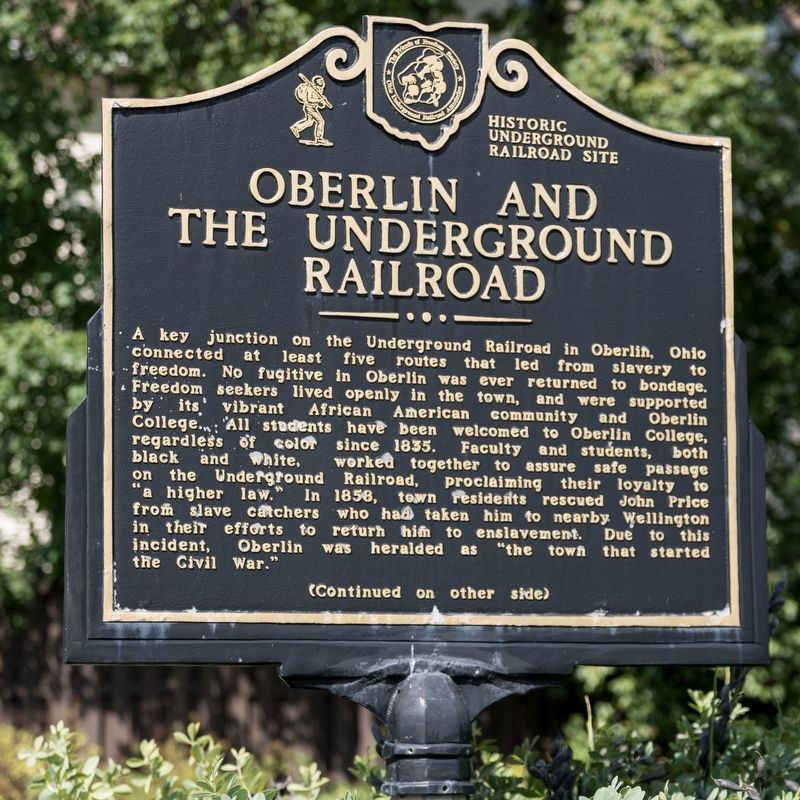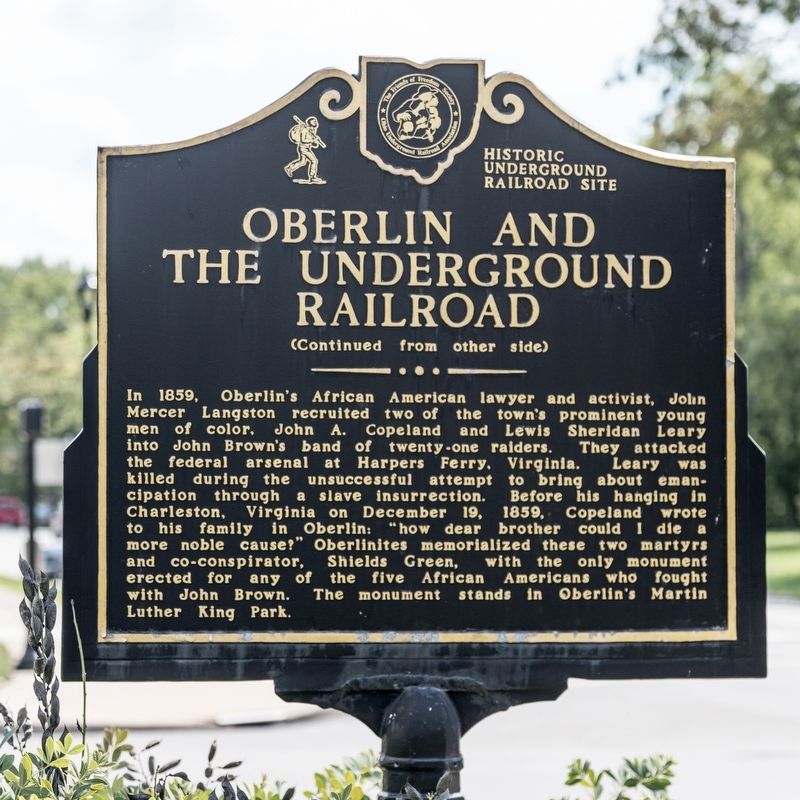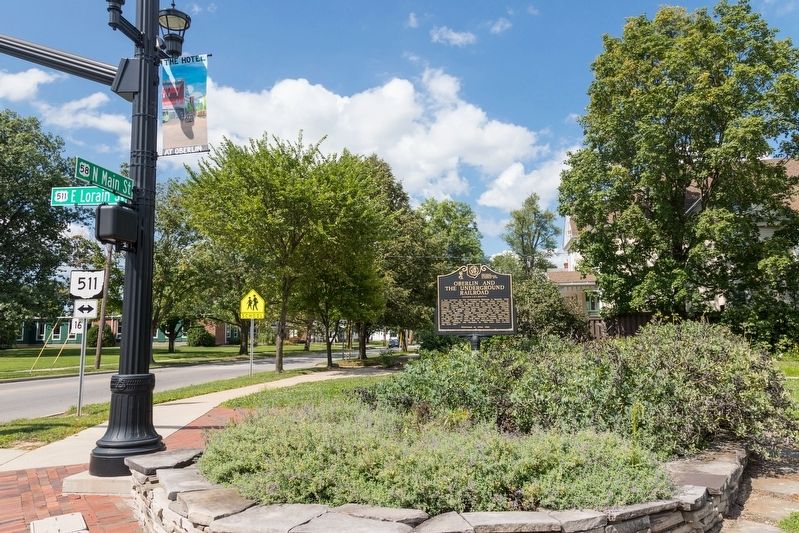Oberlin in Lorain County, Ohio — The American Midwest (Great Lakes)
Oberlin and the Underground Railroad
— Historic Underground Railroad Site —
Inscription.
A key junction on the Underground Railroad in Oberlin, Ohio connected at least five routes that led from slavery to freedom. No fugitive in Oberlin was ever returned to bondage. Freedom seekers lived openly in the town, and were supported by its vibrant African American community and Oberlin College. All students have been welcomed to Oberlin College, regardless of color since 1835. Faculty and students, both black and White, worked together to assure safe passage on the Underground Railroad, proclaiming their loyalty to “a higher law.” In 1858, town residents rescued John Price from slave catchers who had taken him to nearby Wellington in their efforts to return him to enslavement. Due to this incident, Oberlin was heralded as “the town that started the Civil War.”
In 1859, Oberlin’s African American lawyer and activist, John Mercer Langston recruited two of the town’s prominent young men of color, John A. Copeland and Lewis Sheridan Leary into John Brown’s band of twenty-one raiders. They attacked the federal arsenal at Harpers Ferry, Virginia. Leary was killed during the unsuccessful attempt to bring about emancipation through a slave insurrection. Before his hanging in Charleston, Virginia on December 19, 1859, Copeland wrote to his family in Oberlin: “how dear brother could I die a more noble cause?” Oberlinites memorialized these two martyrs and co-conspirator, Shields Green, with the only monument erected for any of the five African Americans who fought with John Brown. The monument stands in Oberlin’s Martin Luther King Park.
Topics. This historical marker is listed in these topic lists: Abolition & Underground RR • African Americans • War, US Civil. A significant historical date for this entry is December 19, 1859.
Location. 41° 17.661′ N, 82° 13.026′ W. Marker is in Oberlin, Ohio, in Lorain County. Marker is at the intersection of East Lorain Street (Ohio Route 511) and North Main Street (Ohio Route 58), on the right when traveling west on East Lorain Street. Touch for map. Marker is in this post office area: Oberlin OH 44074, United States of America. Touch for directions.
Other nearby markers. At least 8 other markers are within walking distance of this marker. Antoinette Brown Blackwell and First Church in Oberlin (within shouting distance of this marker); Downtown Oberlin Historic District (approx. 0.2 miles away); Willard Van Orman Quine (approx. ¼ mile away); Oberlin College and Community / Abolitionism in Oberlin (approx. 0.3 miles away); Charles M. Hall and Frank M. Jewett (approx. 0.4 miles away); Welcome to Oberlin Heritage Center (approx. 0.4 miles away); The Burrell-King House (approx. 0.6 miles away); Westwood Cemetery (approx. one mile away). Touch for a list and map of all markers in Oberlin.
Also see . . . Chapter 7, The Underground Railroad. From Oberlin: Yesterday, Today, Tomorrow ... Edited by Jan DeMartinis, Jean Ebosh and Gail Wood. Illustrated. Excerpt:
You could stay at the Bardwells for a week or more to regain your strength. You would not have to hide during the day because there were so many free blacks in Oberlin.(Submitted on January 6, 2020.)Also the people of Oberlin would risk their freedom to protect yours. In 1858 black and white Oberlinians rescued runaway slave John Price from slave catchers who had taken him, by force, from Oberlin to Wellington. The slave catchers planned to return him to his southern owners. But John Price was whisked back to Oberlin and sent on his way to Canada. Most Oberlinians did not agree with the Fugitive Slave Law and many were abolitionists who worked to end slavery anywhere in the United States.
If you walked around Oberlin, you’d see all the children in school together, learning to read and write. The school in Oberlin was open to all children, no matter what color of skin they had. There was even a school called the “Liberty School” where grown-ups could learn to read and write.
You would have found out that black and white hands worked together to build First Church. A lot of African-Americans in Oberlin were skilled carpenters and builders.
You would have found that black and white people attend this church, and sit right along side each other listening to the famous white minister, Charles Finney, preach. Black Oberlinians could also choose to worship together, at the Liberty School, or outside if the weather was nice, listening to black preachers.
You would have found that “Patterson’s Corner,” a big brick building on the southeast corner of Main and Lorain Streets, held the grocery store owned by Henry Patterson, an African-American. Several of his older children attended Oberlin College.
Credits. This page was last revised on January 24, 2022. It was originally submitted on January 6, 2020, by J. J. Prats of Powell, Ohio. This page has been viewed 1,112 times since then and 197 times this year. Photos: 1, 2, 3. submitted on January 6, 2020, by J. J. Prats of Powell, Ohio.
Editor’s want-list for this marker. Photo(s) of monument in Martin Luther King Park • Can you help?


